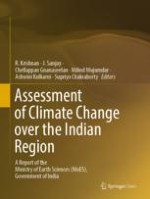-
The tropical Indian Ocean has experienced rapid basin-wide sea surface temperature (SST) warming, with an average rise of 1.0 °C (0.15 °C/decade) during 1951–2015, over which period the global average SST warmed about 0.7 °C (0.11 °C/decade) (high confidence). The SST warming is spatially non-uniform and about 90% of the warming is attributed to anthropogenic emissions.
-
The basin-wide non-uniform SST warming trend in the tropical Indian Ocean is to continue in the future, under both medium and high emission scenarios (high confidence)
-
The frequency of extreme positive Indian Ocean Dipole (IOD) events is projected to increase by almost a factor of three, with one-in-seventeen-year events in the twentieth century to one-in-six-year by the end of the twenty-first century (low confidence).
-
The heat content of the upper 700 m of the Indian Ocean has exhibited an increasing trend during 1955–2015 (high confidence), with spatially non-uniform heating.
-
SST warming has very likely contributed to the decreasing trend observed in oxygen (O2) concentrations in the tropical Indian Ocean, and the declining trend in pH and marine phytoplankton over the western Indian Ocean. These trends are projected to continue with global warming.
10.1 Introduction
10.2 Observed and Projected Changes in Indian Ocean SST
10.2.1 Observed Changes in SST
10.2.2 Attribution of SST Trends to Anthropogenic Emissions
10.2.3 Future Projections of SST Warming
Scenario | Near future | Far future |
|---|---|---|
RCP4.5 | 1.2 °C (± 0.29 °C) | 1.6 °C (± 0.40 °C) |
RCP8.5 | 1.6 °C (± 0.55 °C) | 2.7 °C (± 0.64 °C) |
